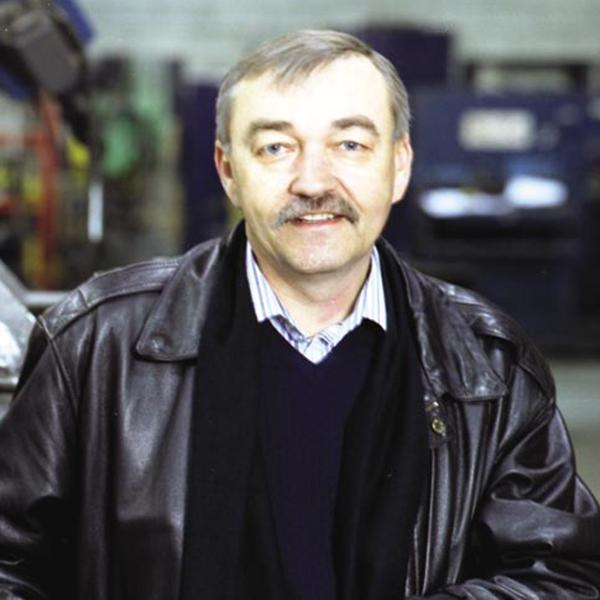
Joe Kubes: Nerves of Steel
Joe Kubes, President of Kubes Steel Ltd., didn’t plan on being a manufacturing maverick; at least not at first. Born in Bosnia, he immigrated to Stoney Creek at the tender age of eight. Despite the barriers of language and culture, he completed public school at the top of his class. His proud parents – a Dofasco millwright and a homemaker – nurtured their son’s obvious academic talents, sending him to Saltfleet High School, where a curriculum of sciences and humanities would groom him for a career in Law or Medicine.
But bored and uninspired, Kubes took little interest in his newfound trajectory. He preferred mechanical pursuits and longed to dabble in the business world. It was not long before he dropped out of high school, taking a job at Burlington Steel while helping his father to operate a small-scale ornamental iron business from the family garage. Dad was a talented artisan who created fireplace screens and fences as a hobby. But his son saw the glint of opportunity, and set his sights on taking the business much further.
Kubes made plans to grow the home-based venture – known in the early days as K&K Ornamental Iron -- into a full-scale company large enough to support both himself and his father on a full-time basis. Kubes envisioned his father retiring from Dofasco some five years down the road and coming to work with him as a business partner. Those plans never materialized – his Dad stayed on at the plant until he retired at age 58. As Kubes would soon learn, it wasn’t the only time things would not unfold according to plan.
He bought a small shop and set to work, but it didn’t take long for Kubes to realize that his options were limited without a high school diploma. He started attending evening classes at Mohawk College, where he completed his high school equivalency. It was the beginning of a lifelong learning process – one that would see his education at the College continue over the next 20 years as Kubes pushed to get the type of manufacturing contracts he really wanted. And as his business took off – it was incorporated as Kubes Steel Limited in 1974 – he looked to Mohawk to furnish him with the necessary skill sets.
“I realized there was a large engineering component to the business, but I didn’t even know how to read a blueprint,” Kubes recalls. “I enrolled in a draftsman program, so I could learn how to make blueprints for my customers. Mohawk offered all of the courses I needed, and it still does.”
Kubes took a full load of accounting courses, along with a variety of business-related subjects through night classes offered at the school. His manufacturing operation meanwhile, continued to be a success -- and was moved to a second location with even more room to grow.
Next, Kubes turned his attention to honing his welding skills. He liked the hands-on training that Mohawk offered, and enrolled in machining courses that taught it all, from the basics right up to the most advanced skills. He graduated with a two-year Welding Technology designation in the early 1980s.
“I received phenomenal instruction, especially from Harry Thomasson (P.Eng.),” says Kubes fondly. “He was probably in his 80s at the time, but he wrote his own books and brought a tremendous amount of talent to the table.” And though the Welding Technology designation is widely taught today, Mohawk was the only college offering it at the time.
When it comes to applying his education to the business world, Kubes voices only one regret: “There’s nothing like getting an education during the day and going (to classes) full time, because of the relationships you can build with alumni. Getting to know your classmates is important for the bonds you’ll develop later in business, and I didn’t have that advantage to the same degree.”
Although he would have welcomed the chance to know his classmates better, Kubes did not allow this perceived shortcoming to slow him down. As a dedicated businessman with a strong work ethic, he built Kubes Steel Ltd. Into a top producer of quality custom fabricated steel products with an unwavering reputation for quality.
Kubes Steel serves a variety of industries, including Steel, Mining, Cement, Chemical, Petro-Chemical, Power Generation, Manufacturing and Construction. The company’s 20,000-square-foot machine shop offers the latest in Computer Numeric Control (CNC) technology, while the 40,000-foot fabrication plant boasts a 40-tonne capacity, with provisions for custom rolling, forming and plasma cutting.
Through much of its 30-year history, Kubes Steel has performed structural section and plate rolling and forming for architectural, structural, manufacturing, mining and mechanical applications. The array of machines at the Stoney Creek plant is capable of performing both the largest and smallest jobs, from the manufacture of machined-quality seal rings and tiny formed pipes, to the rolling out of 36-foot beams on the massive Roundo R13s.
With these facilities at the ready, Kubes produces a wide variety of familiar products such as storage tanks, ducting and dust collectors. Some of his more specialized wares include hoods and stacks, machine components, pipe bridges and turbines.
“As we grew, we kept moving higher up the food chain. The goal was to work not just through contractors, but to be able to supply Dofasco directly. But you can’t be a vendor for them without the appropriate technology or infrastructure; so the business was acquired gradually, one step at a time.”
And as the scope of his projects grew, so did the length of Kubes’ course transcript, as he continued to equip himself for the changing needs of the manufacturing market. In later years, he looked to Mohawk for technical competency and computer courses. The practicality and hands-on approach of his education is something Kubes now looks for when hiring new recruits.
“Around here, when you’re hiring local people with a college education, it’s usually from Mohawk,” he reflects. Most of his employees have shared his Alma Mater, which he appreciates. “They’ve all been very professional young people – very practical kids. Unlike university grads, they’re not theoretical. They come here and they’re ready to work.”
And that work has paid off. Over the past five years, Kubes has been growing what he calls the “rolling and bending” side of his business, which harks back to the early days, when artistic vision played a larger role in the company’s designs.
One stunning example in his company portfolio is the Hamilton Waterfront sculpture known as “Ráfaga – Unleashed”, an installation erected by Veronica and Edwin Dam de Nogales this past year, located at Pier 8 alongside the Canada Marine Discovery Centre. Kubes describes the sculpture as “a 60-foot sail made of stainless steel,” but it is also a testament to the talent of his team and their ability to blend grace, strength and design perfection. Because no welding was allowed at the pier, the huge steel abstract was created in three parts at the plant, and machined to fit together perfectly once onsite. The resulting sculpture looks as if it’s about to take flight -- and Kubes remains tight-lipped about the process, saying only, “a little bending can make a lot of difference.”
Kubes’ manufacturing finesse has been commissioned for artistic and architectural projects across North America: trellises and Equinox models were recently completed for display in Central Park, New York City; and a stunning circular staircase for Avon World Headquarters in downtown Manhattan offered another welcome chance to turn heads south of the border.
And though these projects are among his favourites, it’s likely we’ve all seen examples of Kubes’ work in our day-to-day travels. His company is bending the metal tubes that add eye candy to the entranceways of the newly renovated Leon’s furniture stores, as well as architectural accents for Audi and Volkswagen dealerships across the continent.
“I’ve bought and developed equipment that allows me to do all sorts of fabricating,” notes Kubes in his typically understated style. “But half of our business these days is rolling and bending metal for architects and engineers.”
Kubes imports much of his inspiration for such projects from his frequent visits to Europe, where he describes building trends as “10 to 15 years ahead of us, architecturally speaking. The look of curved steel and glass is popular there, so we bring the European technology home and promote it to architects and engineers (in North America). We let them know that we have the technology, and they can come to someone like us to get it made.”
The education never ends – and in all the lessons he’s learned in college and in life, Kubes offers up the works of two business legends as a sendoff to fellow Mohawk graduates as they begin their own careers:
“Before you go out into the working world, read two books: Think and Grow Rich by Napoleon Hill and How to Win Friends and Influence People by Dale Carnegie.” Adds Kubes, “You’ll never have to look back.”
By: Kate Schooley
This story was originally published in Spring 2005 of the Mohawk Alumni In Touch magazine.
More Featured Alumni
When Témo Cruz enrolled in Mohawk College’s Architectural Technology Program, he never imagined it would introduce him to the world of shipping con
Mohawk alumnus Greg Gagnon has “it”. Expertise, character and passion that have led to two high esteemed awards.
After graduating from Mohawk College's Recreation and Leisure program, the world called, and Iuliana Raducanu answered.







